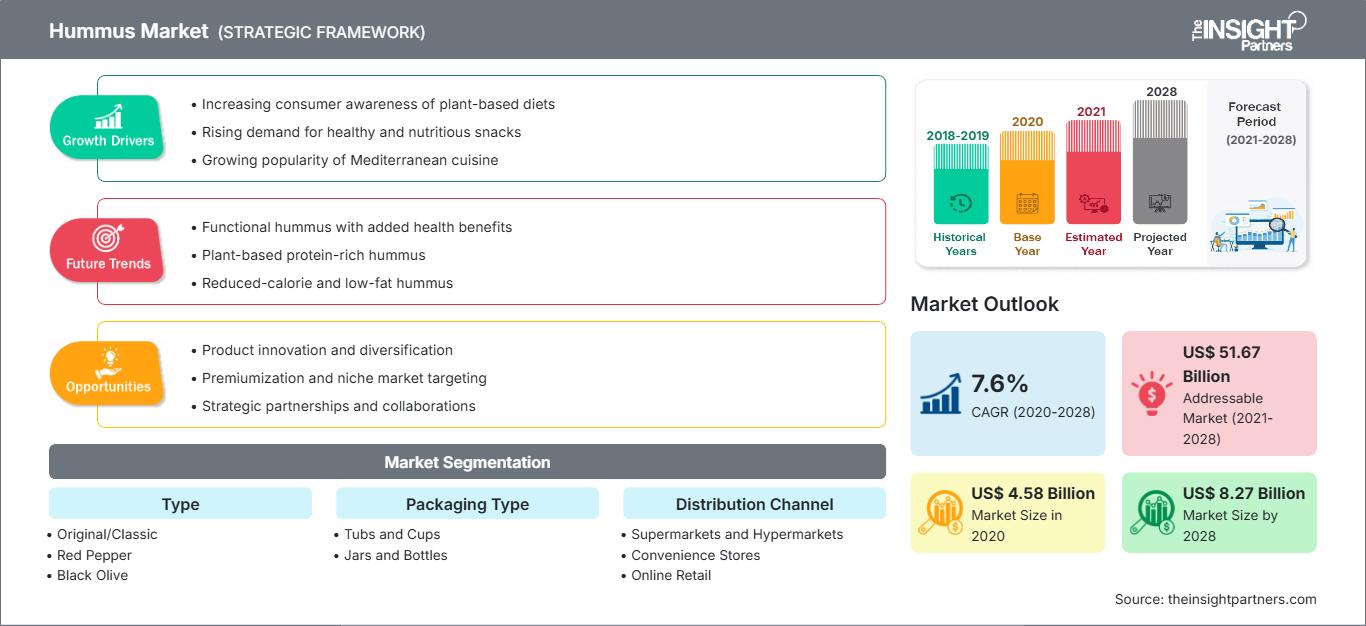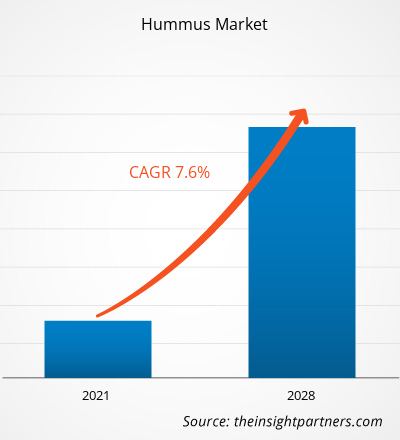Der Hummus-Markt wurde im Jahr 2020 auf 4.577,35 Millionen US-Dollar geschätzt und soll bis 2028 8.267,07 Millionen US-Dollar erreichen; von 2021 bis 2028 wird ein durchschnittliches jährliches Wachstum von 7,6 % erwartet.
Hummus ist ein bekannter Dip und Brotaufstrich aus dem Nahen Osten mit einem hohen Gehalt an Mineralien, Vitaminen, Proteinen und Ballaststoffen. Alle Hauptzutaten von Hummus – Kichererbsen, Knoblauch, Sesamsamen oder -paste (Tahini) und Olivenöl – gelten als Superfoods. Kichererbsen sind reich an Eisen, Phosphor und Vitamin B-Komplex. Tahini hat einen hohen Gehalt an Zink, Kalzium, Kupfer und Phosphor. Zitronensaft ist eine ausgezeichnete Quelle für Vitamin C und Antioxidantien. Knoblauch, der Hummus Geschmack verleiht, ist mit Antioxidantien, Spurenelementen und Vitaminen angereichert.
Der Hummus-Markt im asiatisch-pazifischen Raum wird zwischen 2021 und 2028 voraussichtlich die höchste durchschnittliche jährliche Wachstumsrate (CAGR) aufweisen. Mit dem Wirtschaftswachstum und der zunehmenden Verbreitung verschiedener Krankheiten haben sich Lebensstil und Konsumgewohnheiten in Ländern wie Indien, China und Japan verändert. Darüber hinaus wächst der Trend zum Veganismus mit dem zunehmenden Bewusstsein für die Notwendigkeit des Umweltschutzes. Die steigende Nachfrage nach pflanzlichen Proteinen und das zunehmende Gesundheitsbewusstsein sind die Hauptfaktoren, die das Marktwachstum in der Region vorantreiben. Auch in Europa ist die Nachfrage nach pflanzlichen Proteinen aufgrund der zunehmenden Akzeptanz des Veganismus, insbesondere in Großbritannien, hoch. Darüber hinaus erweitern Hummus-Hersteller ihre Produktlinien, indem sie Bio-Varianten sowie innovative Geschmacksrichtungen auf den Markt bringen.
Die COVID-19-Pandemie hat die Entwicklung des Hummus-Marktes gebremst, hauptsächlich aufgrund von Störungen in der Rohstoffproduktion und Lieferketten, Wetterunsicherheiten und anderen Gründen. Der Ausbruch beeinträchtigte die betriebliche Effizienz und die Wertschöpfungsketten aufgrund der plötzlichen Schließung nationaler und internationaler Grenzen. Da viele Volkswirtschaften jedoch um eine Wiederbelebung und Normalisierung ihrer Geschäftstätigkeit bemüht sind, wird die Nachfrage nach Hummus in absehbarer Zukunft voraussichtlich steigen. Die zunehmende Vorliebe für einen gesunden Lebensstil und die Fokussierung auf immunstärkende Lebensmittel dürften das Wachstum des Hummus-Marktes in den kommenden Jahren weiter begünstigen. Darüber hinaus werden Hummus-Hersteller voraussichtlich Online-Vertriebskanäle für ihre Geschäftsexpansion nutzen. Dies liegt vor allem an der zunehmenden Online-Bestellung von Lebensmitteln, um Menschenansammlungen zu vermeiden und die Abstandsregeln einzuhalten. Der Lebensmitteleinzelhandel arbeitet bereits nach strengen Hygienerichtlinien; viele von ihnen ergreifen jedoch zusätzliche Vorkehrungen, um den persönlichen Kontakt zu minimieren. Zu den Sicherheitsmaßnahmen der Unternehmen gehören die Begrenzung des direkten Kontakts mit Lkw-Fahrern und anderen Besuchern, die Kommunikation und Hervorhebung angemessener Hygienepraktiken sowie die Durchführung umfassender Hygienemaßnahmen und die Vermeidung von Personalkontakten während des Schichtwechsels.
Passen Sie diesen Bericht Ihren Anforderungen an
Sie erhalten kostenlos Anpassungen an jedem Bericht, einschließlich Teilen dieses Berichts oder einer Analyse auf Länderebene, eines Excel-Datenpakets sowie tolle Angebote und Rabatte für Start-ups und Universitäten.
Hummus-Markt: Strategische Einblicke

-
Holen Sie sich die wichtigsten Markttrends aus diesem Bericht.Dieses KOSTENLOSE Beispiel umfasst Datenanalysen, die von Markttrends bis hin zu Schätzungen und Prognosen reichen.
Hummus ist ein bekannter Dip und Brotaufstrich aus dem Nahen Osten mit einem hohen Gehalt an Mineralien, Vitaminen, Proteinen und Ballaststoffen. Alle Hauptzutaten von Hummus – Kichererbsen, Knoblauch, Sesamsamen oder -paste (Tahini) und Olivenöl – gelten als Superfoods. Kichererbsen sind reich an Eisen, Phosphor und Vitamin B-Komplex. Tahini hat einen hohen Gehalt an Zink, Kalzium, Kupfer und Phosphor. Zitronensaft ist eine ausgezeichnete Quelle für Vitamin C und Antioxidantien. Knoblauch, der Hummus Geschmack verleiht, ist reich an Antioxidantien und enthält viele Spurenelemente und Vitamine. Die steigende Prävalenz von Krankheiten wie Schlaganfällen, ischämischer Herzkrankheit, chronisch obstruktiven Lungenerkrankungen und Diabetes mellitus lenkt die Aufmerksamkeit der Menschen auf gesunde Lebensmittel, insbesondere in Industrie- und Entwicklungsländern. Dank der Diversifizierung der Vertriebskanäle hat Hummus auch im Einzelhandel und in Supermärkten Einzug gehalten. Es ist von Natur aus frei von gängigen Allergenen und Reizstoffen wie Nüssen, Gluten und Milchprodukten. Es kann auch als Ersatz für cremige Salatdressings, Mayonnaise, Sauerrahm, Ranch-Dressing und andere Würzmittel in Rezepten wie Sandwiches, Brot, Crackern und Chips verwendet werden. Darüber hinaus steigern steigende wirtschaftliche Standards und verfügbare Einkommen sowie die Diversifizierung der Ernährungsvorlieben die Nachfrage nach gesunden Lebensmitteln wie Hummus. Daher steigern die Vorteile von Hummus, wie eine bessere Verdauung, angemessene Gewichtsabnahme, verbesserte Blutzuckerkontrolle, entzündungshemmende Wirkung und ein geringeres Risiko für Herzerkrankungen, die Nachfrage.
Sorteneinblicke
Basierend auf den Sorten ist der Hummus-Markt in Original/Klassisch, rote Paprika, schwarze Oliven, weiße Bohnen und andere unterteilt. Das Segment „Sonstige“ umfasst hauptsächlich Hummus aus Roter Bete, Schwarzen Bohnen, Lupinen, Edamame, Jalapeño, schwarzem Knoblauch und gelben Linsen. Die geröstete Rote Bete verleiht dem Hummus Süße und eine leuchtend rosa Farbe. Rote-Bete-Hummus ist ein pflegeleichtes Rezept mit einem beeindruckenden Aussehen. Schwarze Bohnen sind eine kleine und glänzende Sorte gewöhnlicher Bohnen und sehr nahrhaft, da sie Antioxidantien, Ballaststoffe, Proteine und Kohlenhydrate enthalten. Schwarze Bohnen und Lupinen werden in den jeweiligen Hummus-Sorten als Kichererbsenersatz verwendet. Rezepte mit diesen Bohnen können je nach Kohlenhydratgrenze in die Keto-Diät integriert werden. Lupinen, gelbe Linsen, verleihen traditionellem Hummus eine intensive Farbe und einen würzigen Geschmack. Jalapeños sind leuchtend grün und verleihen dem Hummus Frische. Sie verstärken außerdem die Schärfe des traditionellen Hummus. Darüber hinaus ist schwarzer Knoblauch-Hummus mit verschiedenen Nährstoffen und Antioxidantien angereichert. Darüber hinaus verleiht der schwarze Knoblauch dem Hummus einen warmen und milden Geschmack.
Einige der wichtigsten Marktteilnehmer auf dem Hummus-Markt sind Bakkavor Group, Cedar’s Mediterranean Foods Inc., Haliburton International Foods, Strauss Group, Tribe Hummus, Hope Foods, LLC, Fountain of Health, Hummus Goodness, Boar’s Head Brand und Lantana Foods. Wichtige Marktteilnehmer konzentrieren sich auf Strategien wie Fusionen und Übernahmen sowie Produkteinführungen, um ihre geografische Präsenz und Kundenbasis zu erweitern.
Berichts-Spotlights
Progressive Trends in der Hummus-Branche
- um Akteuren bei der Entwicklung effektiver langfristiger Strategien zu helfen
- Geschäftswachstumsstrategien von Unternehmen zur Sicherung des Wachstums in entwickelten und sich entwickelnden Märkten
- Quantitative Analyse des globalen Hummus-Marktes von 2019 bis 2028
- Schätzung der Nachfrage nach Hummus in verschiedenen Branchen
- PEST-Analyse zur Veranschaulichung der Wirksamkeit von in der Branche tätigen Käufern und Lieferanten zur Vorhersage des Marktwachstums
- Jüngste Entwicklungen zum Verständnis des Wettbewerbsmarktszenarios und der Nachfrage nach Hummus
- Markttrends und -aussichten in Verbindung mit Faktoren, die das Wachstum des Hummus-Marktes vorantreiben und hemmen
- Verständnis der Strategien, die das kommerzielle Interesse im Hinblick auf das Wachstum des globalen Hummus-Marktes untermauern, zur Unterstützung des Entscheidungsprozesses
- Hummus-Marktgröße an verschiedenen Marktknotenpunkten
- Detaillierte Übersicht und Segmentierung des globalen Hummus-Markt sowie seine Branchendynamik
- Hummus-Marktgröße in verschiedenen Regionen mit vielversprechenden Wachstumschancen
Hummus-Markt
Die Analysten von The Insight Partners haben die regionalen Trends und Faktoren, die den Hummus-Markt im Prognosezeitraum beeinflussen, ausführlich erläutert. In diesem Abschnitt werden auch die Hummus-Marktsegmente und die geografische Lage in Nordamerika, Europa, dem asiatisch-pazifischen Raum, dem Nahen Osten und Afrika sowie Süd- und Mittelamerika erörtert.Umfang des Hummus-Marktberichts
| Berichtsattribut | Einzelheiten |
|---|---|
| Marktgröße in 2020 | US$ 4.58 Billion |
| Marktgröße nach 2028 | US$ 8.27 Billion |
| Globale CAGR (2020 - 2028) | 7.6% |
| Historische Daten | 2018-2019 |
| Prognosezeitraum | 2021-2028 |
| Abgedeckte Segmente |
By Typ
|
| Abgedeckte Regionen und Länder |
Nordamerika
|
| Marktführer und wichtige Unternehmensprofile |
|
Dichte der Hummus-Marktakteure: Auswirkungen auf die Geschäftsdynamik verstehen
Der Hummus-Markt wächst rasant, angetrieben von der steigenden Nachfrage der Endverbraucher aufgrund von Faktoren wie sich entwickelnden Verbraucherpräferenzen, technologischem Fortschritt und einem größeren Bewusstsein für die Vorteile des Produkts. Mit steigender Nachfrage erweitern Unternehmen ihr Angebot, entwickeln Innovationen, um den Bedürfnissen der Verbraucher gerecht zu werden, und nutzen neue Trends, was das Marktwachstum weiter ankurbelt.

- Holen Sie sich die Hummus-Markt Übersicht der wichtigsten Akteure
- Original/Klassisch
- Rote Paprika
- Schwarze Oliven
- Weiße Bohnen
- Andere
Hummus-Markt nach Verpackungsart
- Becher und Tassen
- Gläser und Flaschen
- Andere
Hummus-Markt nach Verpackungsart
- Supermärkte und Hypermärkte
- Convenience Stores
- Online-Einzelhandel
- Andere
Firmenprofile
- Bakkavor Group
- Cedar’s Mediterranean Foods Inc.
- Haliburton International Foods
- Strauss Group
- Tribe Hummus
- Hope Foods, LLC
- Brunnen der Gesundheit
- Hummus-Güte
- Boar’s Head Brand
- Lantana Foods
- Historische Analyse (2 Jahre), Basisjahr, Prognose (7 Jahre) mit CAGR
- PEST- und SWOT-Analyse
- Marktgröße Wert/Volumen – Global, Regional, Land
- Branchen- und Wettbewerbslandschaft
- Excel-Datensatz
Aktuelle Berichte
Erfahrungsberichte
Grund zum Kauf
- Fundierte Entscheidungsfindung
- Marktdynamik verstehen
- Wettbewerbsanalyse
- Kundeneinblicke
- Marktprognosen
- Risikominimierung
- Strategische Planung
- Investitionsbegründung
- Identifizierung neuer Märkte
- Verbesserung von Marketingstrategien
- Steigerung der Betriebseffizienz
- Anpassung an regulatorische Trends






















 Kostenlose Probe anfordern für - Hummus-Markt
Kostenlose Probe anfordern für - Hummus-Markt